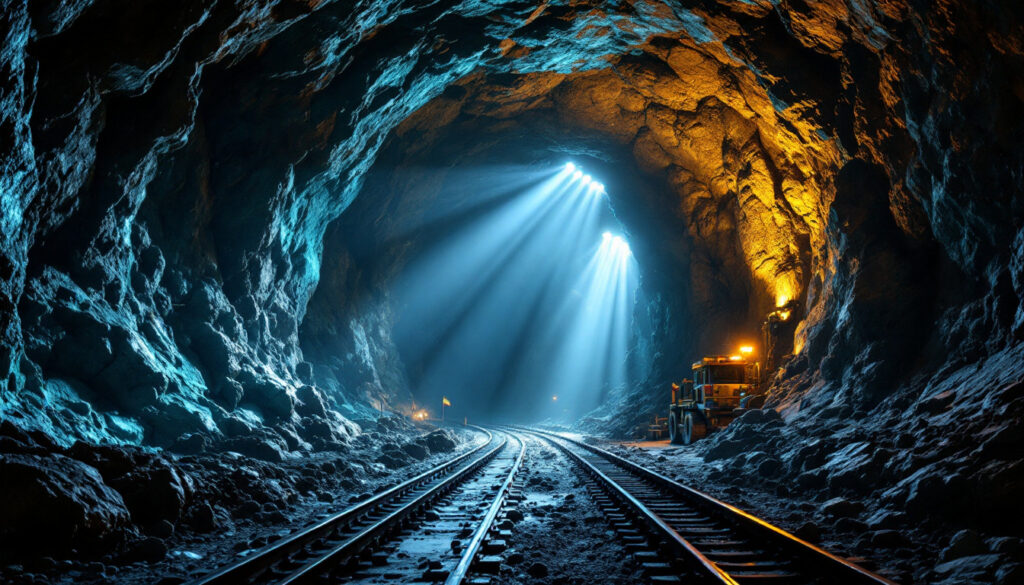Sandfire Resources: Unlocking New Potential at Spanish MATSA Mining Hub
The MATSA mining hub represents one of Sandfire Resources' (ASX:SFR) most strategic international assets, forming a cornerstone of the company's global copper portfolio expansion beyond its Australian operations. Located in Spain's mineral-rich Iberian Pyrite Belt, this multi-mine operation has transformed Sandfire from a single-mine Australian producer into a diversified global mining company with significant European exposure.
What is the MATSA Mining Hub and Why is it Important?
The MATSA (Minas de Aguas Teñidas) mining complex comprises three underground mining operations—Aguas Teñidas, Magdalena, and Sotiel—situated in Spain's southwestern Andalusia region. This mining hub has emerged as the flagship international asset in Sandfire Resources' expanding global copper portfolio.
The Strategic Importance of MATSA
The MATSA operation sits atop the legendary Iberian Pyrite Belt, one of the world's richest Volcanogenic Massive Sulfide (VMS) provinces stretching across southern Spain and Portugal. This geological formation has been actively mined for over 5,000 years, dating back to the Phoenician and Roman eras.
MATSA's strategic value comes from several key attributes:
- Polymetallic production profile: Produces copper, zinc, lead concentrates with gold and silver credits
- Established infrastructure: Modern processing facilities with 4.7Mtpa capacity
- Proximity to markets: Located near European manufacturing centers, reducing transportation costs
- Growth potential: Extensive regional exploration opportunities within the 2,450km² land package
According to mining industry analysts, Sandfire's acquisition of MATSA in 2021 for US$1.865 billion represented a transformational deal, instantly doubling the company's production capacity and providing geographical diversification away from its DeGrussa operation in Western Australia.
Historical Context of the Spanish Mining Region
The Iberian Pyrite Belt represents one of the world's oldest continuously mined regions. Archaeological evidence suggests copper extraction began around 3000 BCE, while industrial-scale mining accelerated during the 19th century when British and French companies developed numerous operations across the region.
"The Iberian Pyrite Belt is unmatched globally in terms of metal concentration per square kilometer, with over 1,600 million tons of sulfide mineralization identified to date. The belt continues to yield new discoveries despite its extensive mining history," notes Dr. Fernando Tornos, Research Professor at Spain's Geological and Mining Institute.
Modern mining at MATSA began in 1995 with the reopening of the Aguas Teñidas mine, while the Magdalena deposit was discovered in 2013. Prior to Sandfire's acquisition, MATSA was owned by Trafigura and Mubadala Investment Company, who invested significantly in modernizing the operation and expanding processing capacity.
What Recent Exploration Results Reveal About MATSA's Potential?
Sandfire Resources recently announced compelling exploration results from an extensive drilling programs overview at MATSA, highlighting the significant upside potential remaining within this mature mining district.
Comprehensive Drilling Program Overview
Between October 25, 2024, and April 11, 2025, Sandfire completed 68 exploration drill holes focused on resource extension and near-mine targets. The program delivered impressive results with 36 holes (53%) intersecting significant mineralization, substantially above the industry average success rate for brownfield exploration.
Sandfire CEO Brendan Harris noted in a recent statement: "These results confirmed that mineralization extends beyond the current mine plan in high-priority target areas, potentially extending mine life and increasing resource tonnage and grade at both Magdalena and Aguas Teñidas deposits."
The company deployed multiple underground and surface drill rigs concurrently, targeting extensions to known orebodies while also testing several conceptual targets identified through advanced geophysical modeling.
Magdalena Deposit: Key Findings
The Magdalena deposit has emerged as the standout performer in MATSA's portfolio, delivering exceptional copper-rich intercepts from the recent drilling campaign:
- Hole MR422: 5.5 meters at 2.9% copper, 0.1% zinc, 0.1% lead, 2 g/t gold, and 11.6 g/t silver from 517 meters
- Hole MR425: 7.2 meters at 2.3% copper, 0.3% zinc, 0.1% lead, 1.7 g/t gold, and 9.8 g/t silver from 523 meters
- Hole MR430: 4.8 meters at 3.1% copper, 0.2% zinc, trace lead, at 1.9 g/t gold, and 12.3 g/t silver from 532 meters
These intercepts are particularly significant as they occur outside the current mine plan boundaries, suggesting potential resource expansion to the southeast where the mineralization remains open.
Geologically, the Magdalena deposit is characterized by a massive sulfide lens with a copper-rich core grading into more zinc-dominant mineralization toward the periphery—typical of well-preserved VMS deposit insights. The recent drilling indicates the high-grade copper core extends further than previously modeled.
Aguas Teñidas Deposit: Promising Results
At Aguas Teñidas, the longest-operating mine in the MATSA complex, drilling has confirmed substantial zinc-rich extensions:
- Hole ATD-531: 13.9 meters at 1.3% copper, 8% zinc, 2.1% lead, 0.7 g/t gold, and 45.3 g/t silver from 189.2 meters
- Hole ATD-534: 11.2 meters at 0.9% copper, 7.3% zinc, 1.8% lead, 0.5 g/t gold, and 39.7 g/t silver from 195.6 meters
These grades significantly exceed the current resource average of 5.2% zinc at Aguas Teñidas, suggesting potential for grade improvement in future mining areas. The polymetallic nature of these intercepts—with strong silver credits—enhances their economic potential, providing natural hedging against individual metal price fluctuations.
Mining engineers note that the relatively shallow depth of these new intercepts at Aguas Teñidas (under 200 meters) would require minimal additional development capital to access, potentially providing quick returns on exploration investment.
How Do These Findings Impact Sandfire's Future Operations?
The recent exploration success at MATSA has significant implications for Sandfire's operational strategy and medium-term production outlook.
Resource Expansion Potential
The drilling results demonstrate clear potential for resource growth along three dimensions:
- Lateral extensions: Particularly at Magdalena where mineralization continues beyond current mine boundaries
- Depth extensions: Several deeper holes confirmed mineralization continues at depth
- Grade improvements: Particularly at Aguas Teñidas where zinc grades exceed current reserve averages
Mining analysts estimate these results could eventually translate to a 15-20% increase in contained metal at MATSA, though formal resource updates will require additional infill drilling and economic assessments.
The most immediate impact will likely be seen at Magdalena, where high-grade copper extensions could be incorporated into near-term mine plans. Industry experts suggest that each year of additional mine life at current production rates could add approximately US$75-100 million to the net present value of the operation.
Strategic Development Plans
Sandfire has outlined a strategic approach to MATSA's ongoing development:
- Intensified drilling: Continued focus on high-priority targets at Magdalena's southeastern extension
- Infrastructure development: Planned exploration drive to support targeted drilling at Masa 2 West
- Modernization initiatives: Ongoing optimization of processing facilities to improve recoveries
- Regional exploration: Assessment of satellite deposits within the broader land package
"We are particularly excited about the planned exploration drive to support drilling at Masa 2 West, which represents one of our highest-priority targets," noted CEO Brendan Harris in Sandfire's latest exploration update.
The company has allocated an additional €8.5 million for exploration at MATSA in the coming fiscal year, representing a 22% increase over previous budgets—a strong vote of confidence in the operation's growth potential.
Economic Implications
The economic impact of these exploration results extends beyond simple mine life extension:
- Production profile: Potential to maintain or increase current production rates beyond the existing mine plan
- Cost structure: Higher grades typically translate to lower per-unit production costs
- Revenue mix: Increased zinc content at Aguas Teñidas may shift the revenue balance between metals
- Capital efficiency: Near-mine discoveries require substantially less development capital than greenfield projects
Financial analysts note that these extensions are particularly valuable in the current market environment, with copper price prediction models suggesting strong prices due to electrification trends and zinc fundamentals improving on supply constraints.
What Makes MATSA a Unique Mining Operation?
Several distinctive characteristics differentiate MATSA from peer operations globally, creating both opportunities and challenges for Sandfire.
Polymetallic Nature of the Deposits
Unlike many copper operations that produce a single dominant metal, MATSA's deposits yield a diverse mix of valuable minerals:
| Metal | Typical Contribution to Revenue | Current Market Outlook |
|---|---|---|
| Copper | 55-65% | Strong long-term fundamentals |
| Zinc | 25-35% | Improving on supply constraints |
| Lead | 5-8% | Stable industrial demand |
| Silver | 3-6% | Moderate upside potential |
| Gold | 2-4% | Safe-haven investment appeal |
This polymetallic profile provides natural hedging against individual commodity price volatility. During periods of copper price weakness, stronger zinc or precious metals prices can offset revenue declines, stabilizing cash flow compared to pure-play copper producers.
The complex mineralogy does create metallurgical challenges, requiring sophisticated processing techniques to optimize recovery rates and concentrate quality. MATSA's processing facility employs sequential flotation circuits to separate the various metals into marketable concentrates.
Infrastructure Advantages
MATSA benefits from exceptional infrastructure:
- Processing capacity: Modern 4.7 million tonne per annum concentrator
- Logistics: Located just 90km from the Port of Huelva, minimizing transportation costs
- Power supply: Connected to Spain's robust national grid with increasing renewable contribution
- Water access: Established water supply agreements with regional authorities
- Skilled workforce: Located in a region with centuries of mining tradition and expertise
The operation's positioning within the European Union provides both advantages and challenges. While regulatory requirements are stringent, the proximity to European smelters and manufacturing centers creates marketing advantages for MATSA's concentrates.
Technical Mining Considerations
As underground operations, the MATSA mines employ sophisticated mining techniques:
- Mining method: Primarily long-hole open stoping with paste backfill
- Ground support: Systematic bolting and shotcrete in development headings
- Ventilation: Dual-purpose system providing air quality and temperature control
- Water management: Extensive dewatering infrastructure with water treatment facilities
The mines operate at moderate depths (currently 300-700 meters), avoiding some of the challenges faced by ultra-deep operations. However, maintaining efficient operations at depth requires careful planning and substantial technical expertise.
How Does MATSA Fit Into Sandfire's Global Portfolio?
The MATSA complex represents a cornerstone of Sandfire's transformation from a single-mine Australian producer to a diversified global copper company.
Sandfire's Global Copper Strategy
Sandfire's evolution has been remarkable over the past decade:
- 2009-2011: Development of DeGrussa copper-gold mine in Western Australia
- 2012-2019: Single-asset producer focused on operational excellence
- 2019-2021: Initial international expansion with Botswana Motheo project development
- 2021-present: Transformation into multi-asset global producer with MATSA acquisition
With the DeGrussa mine in Australia now closed after depleting its reserves, MATSA currently generates approximately 65-70% of Sandfire's copper equivalent production, with the balance coming from the recently commissioned Motheo operation in Botswana.
This geographic diversification across three continents (Europe, Africa, and Australia) has substantially reduced Sandfire's operational risk profile while positioning the company as a growing mid-tier copper producer with annual production exceeding 100,000 tonnes of copper equivalent.
Comparison to Other Sandfire Assets
MATSA provides several complementary attributes within Sandfire's portfolio:
| Characteristic | MATSA (Spain) | Motheo (Botswana) | DeGrussa (Australia) |
|---|---|---|---|
| Mine type | Underground | Open pit | Underground (depleted) |
| Production profile | Copper, zinc, lead, gold, silver | Copper, silver | Copper, gold |
| Resource size | Large, complex VMS system | Moderate sediment-hosted deposit | Moderate VMS deposit (depleted) |
| Cost position | Mid-second quartile | Low-second quartile | First quartile (historical) |
| Exploration potential | High within existing mining areas | High regional potential | Limited (mature district) |
Industry analysts note that while MATSA operates at slightly higher costs than Sandfire's Motheo project, its polymetallic nature provides valuable diversification benefits, particularly during periods of copper price volatility.
Investment Considerations
From an investment perspective, MATSA represents approximately 60% of Sandfire's net asset value according to consensus analyst estimates. The operation's contribution to overall company valuation depends on several factors:
- Production stability: Consistent delivery against production targets
- Cost control: Managing operating costs in an inflationary environment
- Resource growth: Successfully extending mine life through exploration
- Metal prices: Relative performance of copper versus zinc prices
- Regulatory environment: Managing compliance within the European framework
The recent exploration success suggests potential upside to current valuation assumptions, particularly if Sandfire can demonstrate meaningful mine life extensions.
What Environmental and Social Factors Impact MATSA Operations?
Operating within the European Union regulatory framework, MATSA maintains stringent environmental and social performance standards that influence operational decisions.
Environmental Management
Environmental stewardship represents a core focus area at MATSA:
- Water management: Closed-circuit water recycling system recovers approximately 80% of process water
- Tailings storage: Modern filtered tailings facility with progressive rehabilitation
- Energy efficiency: Implementation of variable speed drives and process optimization
- Carbon footprint: Commitment to 30% emissions reduction by 2030 from 2020 baseline
- Biodiversity protection: Native species reintroduction in rehabilitated areas
Sandfire's sustainability reporting indicates MATSA has achieved ISO 14001 certification for its environmental management systems and continues to implement best practices across its operations.
"Mining in the modern European context requires exceptional environmental performance," notes Dr. Elena Moreno, environmental director at a Spanish mining industry association. "Operations like MATSA demonstrate that responsible mining can coexist with stringent environmental protection."
Community Relations
The MATSA operation has deep connections to local communities:
- Employment: Approximately 1,200 direct employees and contractors, primarily from local communities
- Economic impact: €150+ million annual contribution to regional economy
- Community programs: Education initiatives, cultural preservation projects
- Infrastructure support: Road maintenance and community facility investments
With mining's centuries-long history in the region, many employees represent second or third-generation miners, creating strong community ties and social acceptance of the operation.
Regulatory Framework
Operating within the European Union presents both challenges and opportunities:
- Permitting complexity: Multiple layers of approval required for major projects
- Environmental standards: Among the world's most stringent regulatory requirements
- Reporting obligations: Comprehensive disclosure requirements for environmental and social performance
- Stability: Transparent and consistent regulatory environment
While compliance costs are higher than in some competing jurisdictions, the regulatory stability provides operational predictability that partially offsets these additional expenses.
What's Next for Sandfire at MATSA?
Building on recent exploration success, Sandfire has outlined a comprehensive strategy to maximize MATSA's value contribution.
Near-Term Exploration Priorities
The exploration focus for the coming 12-18 months includes:
- Magdalena extensions: Continued drilling of southeastern extensions where mineralization remains open
- Masa 2 West target: Development of exploration drive to access this high-priority area
- Sotiel optimization: Targeted drilling to improve resource confidence and grade delineation
- Regional targets: Assessment of satellite prospects within transportation distance of the central processing facility
Sandfire has committed to deploying 4-6 drill rigs continuously throughout 2025-2026, reflecting confidence in the exploration potential.
Development Timeline
Key milestones in MATSA's development roadmap include:
- Q3 2025: Completion of Magdalena resource extension drilling
- Q4 2025: Expected resource update incorporating recent drilling results
- Q1 2026: Completion of
Ready to Capitalise on the Next Major Mining Discovery?
Discover significant ASX mineral announcements in real-time with Discovery Alert's proprietary Discovery IQ model, turning complex mineral data into actionable insights for both traders and investors. Explore why historic discoveries can generate substantial returns by visiting Discovery Alert's dedicated discoveries page and begin your 30-day free trial today.




